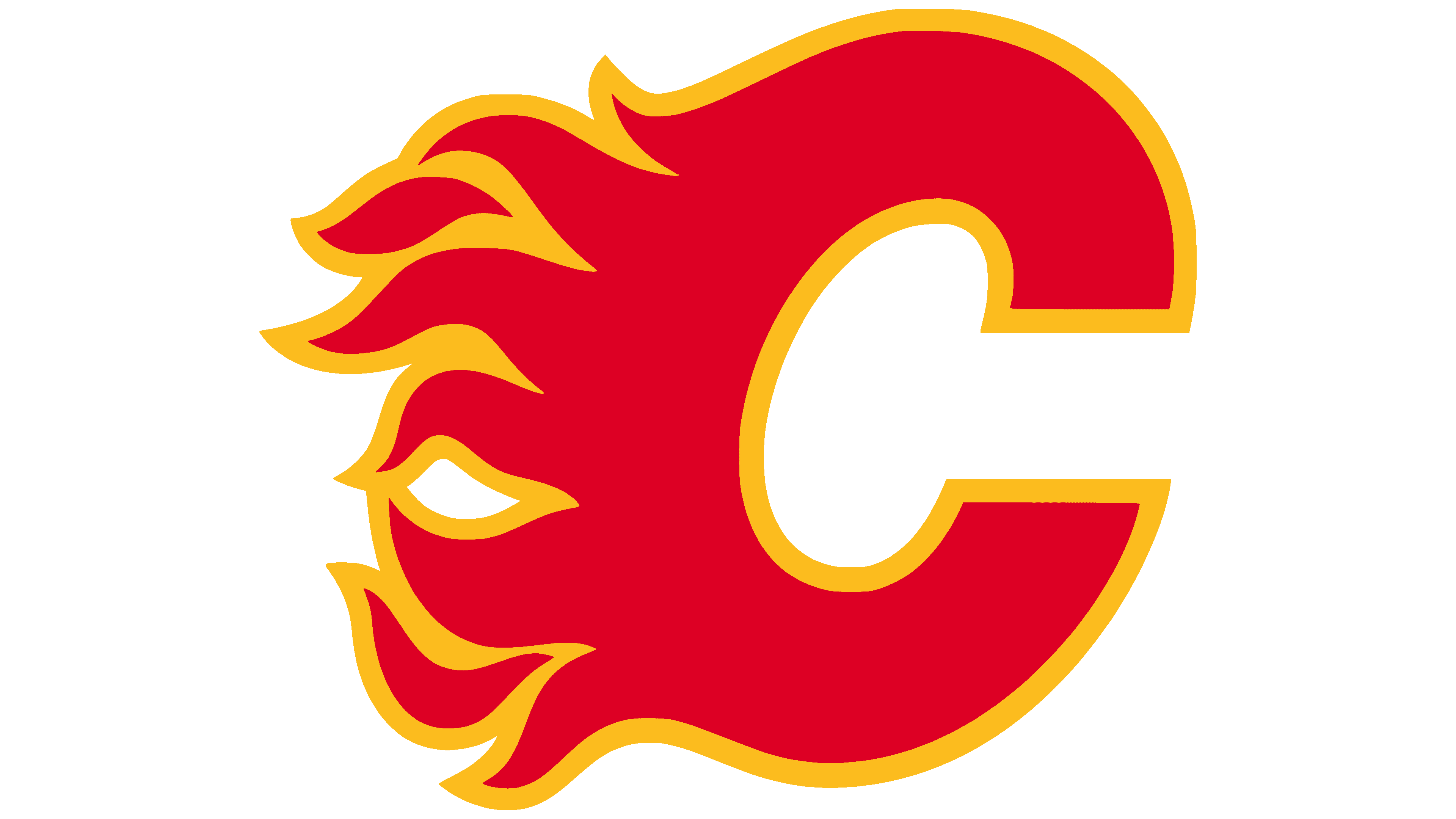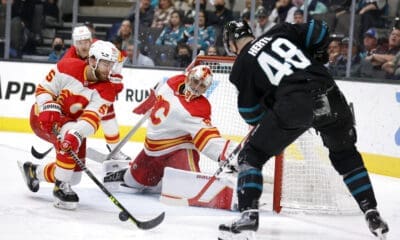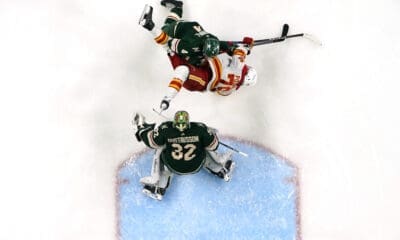Calgary Flames
Calgary Flames vs San Jose Sharks recap: Efficiency and score effects
Score effects made the Sharks look better than they actually were, but the second period was a weird one for the Flames, as they were getting their butts kicked before actually beginning their flurry of goals.

Boy, the Calgary Flames needed that one. Not that they would have been in trouble had they lost the game, but beating the San Jose Sharks – especially in regulation – was crucial. The Flames have now won the season series over both the Sharks and Los Angeles Kings. If it comes down to a tiebreak for a playoff spot between the three, that’s huge. That’s beyond huge. And the Calgary Third Periods became the Calgary Second Periods to get it done.
But what of their underlying numbers? I know, I know – the win's more important, and I'm stoked they won. But we can take a closer look at how they did it, so why not do it? Via HockeyStats.ca, the corsi chart at all situations:
That frantic first period was an outstanding one for the Flames, as they went toe-to-toe with the Sharks. After that, though, the Sharks pulled away, and the Flames were never able to have the puck as much as them. Not that they let it be a problem, as a flurry of chances got them on the board first, followed up by some powerplay time and a strong end, taking advantage of the few chances they generated. After that, the Flames completely fell off, switching to prevention mode rather than try to score more. And it worked, since the Sharks not only plateaued, but didn't score.
But score effects clearly played a role here. In lieu of that, let's take a look at the 5 v 5 even strength score adjusted corsi chart:
The difference here is much more pronounced, especially after Kris Russell’s goal. Which, well, yeah: the Sharks needed offence and the Flames didn’t really care, so long as they defended well. And they, along with Jonas Hiller, absolutely defended well enough.
So, the Sharks had more shot attempts than the Flames for most of the game, and especially at even strength. Where did those shot attempts all come from? Via War on Ice:
Hiller was pretty great. Look at how many times the Sharks got in close on him, only to not score thanks to the current version of our Swiss saviour. Not even from just in tight, as a lot of what San Jose threw at Hiller reached him. Too bad for them he was good enough to stop anybody not named John Scott from scoring.
The Flames, meanwhile, racked up about 50 missed and blocked shot chances on the empty net, as you can see visualized. No question Alex Stalock should have had Russell’s goal. And while the left side of the ice is, once again, busier than the right: the Flames scored a goal from the right side! And actually generated some shots on net from there! Nothing as close from the left, but we’re sure enough seeing a very, very slow, but still existent, improvement.
The above corsi charts do show us a pretty clear distinction between first period and the rest, while the second period was especially notable for the three goals scored. How did that all play out? The period-by-period breakdown, via NaturalStatTrick:
Flames vs Sharks - All Situations

Flames vs Sharks - Even Strength

Flames Even Strength Data
- Here’s something to take note of: the Flames’ top possession players barely played. Matt Stajan, Paul Byron, and Brandon Bollig sat for much of the game, but actually had their busiest period in the third: when their team was simply trying to prevent San Jose from scoring, and not much else. Their incredibly poor zone starts – neither Stajan nor Bollig saw a single offensive zone faceoff – only plays up how well they did, but remember, they were mostly playing against the Sharks’ worst. Although Byron did see more of Joe Thornton and Brent Burns than the other two by a fair amount. That, combined with the fact he still played more than his most regular linemates, just helps show how valuable he is as a bottom six forward.
- There’s kind of a chasm there between Rafa Diaz and Deryk Engelland, eh? And it all comes from the fact that the Flames were more active offensively with Diaz. So Diaz took more chances on offence, and still gave up the same number of shot attempts as his defence partner. And remember: this is all at even strength, so we aren’t even taking Diaz’s powerplay time into account here. (He had an additional four shot attempts on the man advantage.)
- Then, there are the guys at the bottom who barely played and posted poor possession stats. The line of Mason Raymond, Josh Jooris, and Joe Colborne seems to be getting benched as of late. They also had pretty poor zone starts, but played against tougher competition than their fourth line counterparts.
- The top line of Johnny Gaudreau, Sean Monahan, and Jiri Hudler are right down there at the bottom as well. They didn’t have great zone starts either, but primarily faced off against San Jose’s second line, as opposed to their third line counterparts. And it shouldn’t go unstated that Hudler was at the top of them again. He’s the best veteran.
- They didn’t score, but the line of Lance Bouma, Mikael Backlund, and David Jones may very well have been the Flames’ best of the night, all while facing the Sharks’ top line of Thornton, Melker Karlsson, and Joe Pavelski. Their beneficial zone starts definitely helped them, but the line did a great job. They didn’t shut down Thornton, but his chances were more limited when Backlund’s line was out against him.
- TJ Brodie and Mark Giordano both played a buttload of minutes and were near the top of the Flames’ corsi stats, even if they couldn’t break even. They did all this with somewhat poor zone starts (less so relative to the team) and while, as is tradition, playing mostly against the top line. These were the guys who shut down Thornton and co.
- Finally, Russell and Dennis Wideman played the most sheltered minutes available and kinda still got kicked in. That’s never a good sign. They faced off against middle-tier Sharks competition, and the fact they were spending more time chasing the puck than actually having it is not ideal, Russell’s goal be damned. (Well, not be damned, it’s awesome he finally got on the board. Just, you know, it wasn’t reflective of the larger overall play, which continues to point towards the fact that the Flames’ top four is not adequate.)
Player Spotlight - Kris Russell
Russell was the man of the broadcast, what with all the praise for his shot blocking and his apparent destiny to score his first goal of the season. In light of that, let's take a closer look at his performance. He's a part of the Flames' top four, but should the Flames decided to acquire another defenceman, he might find himself bumped down – and into a role he'd be better suited for.
As the only special teams Russell played on was the penalty kill, all the numbers below are at even strength only:
Diaz was one of two guys Russell did not play with at all last night (the other was Engelland, so no bottom pairing matchups for him). That said, how great do you think a bottom pairing of Russell and Diaz would be? Neither is particularly great at handling top competition, but that's a very mobile pair that could thrive against lesser. It would also involve the Flames acquiring another legitimate top four defenceman and actually scratching Engelland, and I'm pretty sure Engelland is unscratchable, so it probably won't happen. Still… it's fun to dream.
by Ari Yanover








